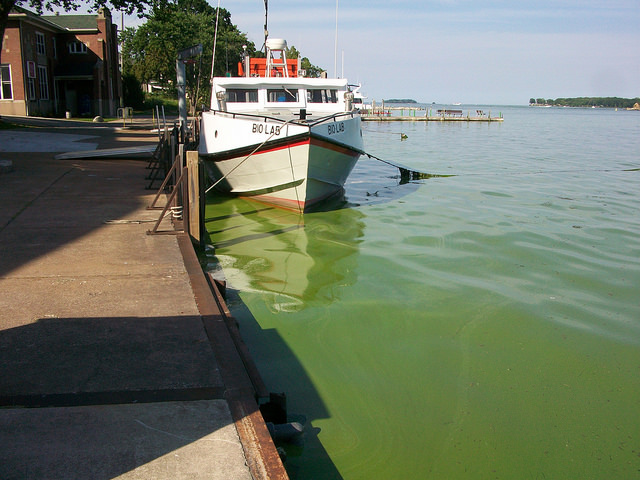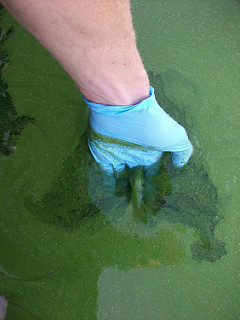
A boat sits in an algae-filled Lake Erie at Stone Lab, a freshwater biological field station and research and teaching center owned by Ohio State. Credit: Courtesy of Christopher Winslow
Ohio State is taking an active role in supporting a deal struck on Feb. 22 between the U.S. and Canada to help reduce the harmful algae-feeding phosphorus entering Lake Erie by 40 percent.
The two countries will work to develop action plans to meet their goals.
Christopher Winslow, the interim director for the Ohio Sea Grant College Program, spoke about the large algal blooms in Lake Erie that led to the decision to promote reduction. The program is based on research, education and outreach in regard to Lake Erie, he said.
“What we’ve got going on is we have an excess input of nutrients into Lake Erie, specifically phosphorus … the blooms happen because this organism, which is naturally occurring in the lake … is able to grow in bloom conditions or excess conditions because there are excess nutrients in the water,” Winslow said.
Excess phosphorus is able to enter the lake through agricultural runoff from fertilizers and manure, failing septic tanks and waste treatment plants that become inundated with too much sewage, Winslow said.
Winslow called this a health hazard.
“These blooms have the potential to produce toxins, and that toxin is pretty dangerous. It is actually known to be more toxic than things like cyanide and ricin,” Winslow said. “If it is at a certain level, and it is consumed by humans, it can cause neurological damage; it can cause liver damage, and, at a minor scale, it can cause skin rashes.”
Jay Martin, a professor in the Department of Food, Agricultural and Biological Engineering, described in an email other ways that phosphorus can be hazardous.

A hand dips into the algae-covered surface of Lake Erie. Credit: Courtesy of Christopher Winslow
“The toxins can directly harm human health and have led to multiple drinking water bans, most notable in Toledo in 2014. Other impacts include beach closures and accumulation of toxins in Lake Erie gamefish,” Martin said. “I will also note that this is a statewide and national issue. Last year, blooms occurred in multiple (Ohio) reservoirs and the Ohio River and other places around the country and world.”
In the face of this proposal to reduce phosphorus levels, Winslow spoke about what OSU is doing to aid in research efforts.
The Ohio Sea Grant College Program donated $500,000 to researchers at Ohio universities to research harmful algal blooms, and Bruce McPheron, the interim executive vice president and provost of OSU, has given $1 million to five different researchers at OSU working on projects surrounding the issue. The Ohio Department of Higher Education has also given a total of $4 million over the past two years, and the majority has gone toward OSU researchers working on the problem, Winslow said.
“The EPA and Environment Canada are currently working on what are called their domestic action plans, so they are really trying to say, ‘OK, we have set 40 percent as the number we need to get to, so how are we going to get there?’ The EPA right now is trying to craft the mechanism on how we get there,” Winslow said. “That is being drafted by consulting with Ohio State University researchers and with Ohio Sea Grant, so the work we are doing is informing (these) domestic action plans.”
Martin said that the project could take more than a decade to reach completion.
“It will probably take at least a decade to reduce the amount of nutrients reaching the lake to an acceptable level,” he said. “The governors of (Ohio) and (Michigan) and the leader of Ontario have signed an agreement to reach this reduction by 2025, so there is a timetable.”


